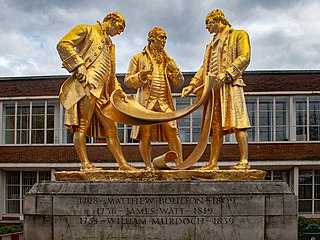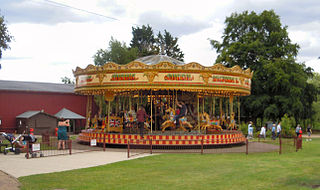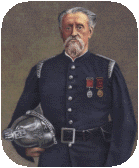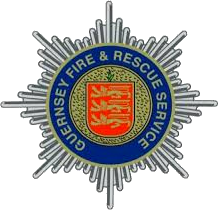
A fire engine or fire truck is a vehicle, usually a specially-designed or modified truck, that functions as a firefighting apparatus. The primary purposes of a fire engine include transporting firefighters and water to an incident as well as carrying equipment for firefighting operations in a fire drill. Some fire engines have specialized functions, such as wildfire suppression and aircraft rescue and firefighting, and may also carry equipment for technical rescue.

Boulton & Watt was an early British engineering and manufacturing firm in the business of designing and making marine and stationary steam engines. Founded in the English West Midlands around Birmingham in 1775 as a partnership between the English manufacturer Matthew Boulton and the Scottish engineer James Watt, the firm had a major role in the Industrial Revolution and grew to be a major producer of steam engines in the 19th century.

A fireboat or fire-float is a specialized watercraft with pumps and nozzles designed for fighting shoreline and shipboard fires. The first fireboats, dating to the late 18th century, were tugboats, retrofitted with firefighting equipment. Older designs derived from tugboats and modern fireboats more closely resembling seafaring ships can both be found in service today. Some departments would give their multi-purpose craft the title of "fireboat" also.

Textile manufacture during the British Industrial Revolution was centred in south Lancashire and the towns on both sides of the Pennines in the United Kingdom. The main drivers of the Industrial Revolution were textile manufacturing, iron founding, steam power, oil drilling, the discovery of electricity and its many industrial applications, the telegraph and many others. Railroads, steamboats, the telegraph and other innovations massively increased worker productivity and raised standards of living by greatly reducing time spent during travel, transportation and communications.

Bressingham Steam & Gardens is a steam museum and gardens located at Bressingham, west of Diss in Norfolk, England. The site has several narrow gauge rail lines and a number of types of steam engines and vehicles in its collection and is also the home of a Dad's Army exhibition.

Warsaw Fire Guard was a fire fighting unit in the city of Warsaw. Formed as Warsaw's first permanent fire service in 1834, it remained an independent and city-owned venture until its nationalization by the Nazi German authorities during the occupation of Poland following the Invasion of Poland of 1939.

Captain Sir Eyre Massey Shaw KCB was the first Chief Officer of the Metropolitan Fire Brigade, and the Superintendent of its predecessor, the London Fire Engine Establishment, from 1861 to 1891. He introduced modern firefighting methods to the Brigade, and increased the number of stations. Prior to entering firefighting, Shaw was in the British Army, followed by a spell as Chief Constable of Belfast Borough Police.

London Museum of Water & Steam is an independent museum founded in 1975 as the Kew Bridge Steam Museum. It was rebranded in early 2014 following a major investment project.

The history of organized firefighting began in ancient Rome while under the rule of the first Roman Emperor Augustus. Prior to that, Ctesibius, a Greek citizen of Alexandria, developed the first fire pump in the third century BC, which was later improved upon in a design by Hero of Alexandria in the first century BC.

Kent Fire and Rescue Service is the statutory fire and rescue service for the administrative county of Kent and the unitary authority area of Medway, covering a geographical area south-east of London, to the coast and including major shipping routes via the Thames and Medway rivers. The total coastline covered is 225 km ; it has 55 fire stations, and four district fire safety offices. The FRS provides emergency cover to a population of nearly 2 million.

Merryweather & Sons of Clapham, later Greenwich, London, were builders of steam fire engines and steam tram engines.

Pyronaut is a specialised form of fireboat known as a fire-float. It was built in 1934 by Charles Hill & Sons Ltd., Albion Dock Bristol, Yard No. 208. Registered number 333833. She is owned by Bristol Museums and based at M Shed in Bristol's Floating Harbour.

James Hall Museum of Transport is a transport museum that aims to preserve and promote the history of over 400 years of transport in South Africa in particular, and Africa in general. It is the largest transport museum in Africa. It is located at Pioneers' Park beside the Wemmer Pan in La Rochelle, Johannesburg, South Africa. It was established in 1964 by Jimmie Hall and the City of Johannesburg.
John Grantham (1809–1874) was an English engineer, born in Croydon Surrey, who was involved in marine, railway and tramway engineering. He was the second son of another John Grantham. After leaving school, John (junior) worked with his father surveying routes for projected railway lines in England.

A firefighting apparatus or firefighting appliance describes any vehicle that has been customized for use during firefighting operations. These vehicles are highly customized depending on their needs and the duty they will be performing. These duties can include firefighting and emergency medical services.

The Guernsey Fire and Rescue Service is the statutory fire and rescue service which deals with a broad range of incidents on Guernsey, including fires, road traffic accidents, assisting property owner after storm damage or flooding and incidents involving hazardous substances.

An electric fire engine is a fire engine that is powered by an electric motor—essentially, an electric vehicle designed and used for firefighting. Electric fire engines were first proposed in the 19th century to replace the steam pumpers used for firefighting. The electric motor was claimed to be simpler, cleaner, and faster in operation, would save money, and require less maintenance than the steam fire engine. Though production of most electric-powered fire engines ended in the early 20th century when they were superseded by diesel-powered fire engines, they have seen a revival in the 21st century, with fire engine manufacturers such as Rosenbauer and Pierce Manufacturing designing their own electric fire engines.
John Morris & Sons Limited of Cross Lane, Salford, Manchester, Lancashire, were manufacturers of all kinds of fire fighting equipment from fire engines, manual then motorised, fire retardant foams, and electrical fire alarms, down to firemen's axes and fire buckets.

The Penrith Museum of Fire is an Australian firefighting museum that contains heritage-listed former operating and stored for preservation fire service vehicles located in Penrith, Sydney, Australia. The provenance of the firefighting vehicles date from 1841 to 1998. The fleet of vehicles was added to the New South Wales State Heritage Register on 25 February 2013.

The Grenville steam carriage was developed in 1875 by Robert Neville-Grenville, assisted by George Jackson Churchward. It was built around a boiler from a Merryweather & Sons fire engine, and could carry seven people including the driver, steersman and stoker.



















